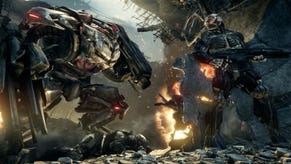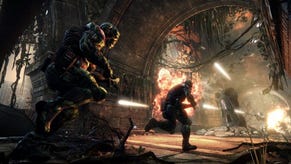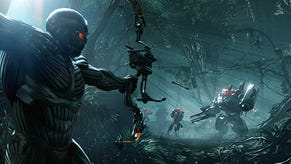Wot I Think: Crysis 2
Crysis 2 is now available in both Europe and North America. The sequel to the Crytek's PC-only 2007 technology showcase FPS, Crysis, it's one of the most intensely anticipated games of 2011. And it's now multi-platform, too. What does that all mean for us?
Well, it's a given that many computer dudes will get shot, but just how good is the shooting? And should this sparkling sci-fi spectacle be sat at the top of your shopping list? (Probably.) Here's Wot I Think.
There seems little reason to pretend that Crysis 2 is anything much without its visuals. The engine is still the star here, even with DX9 and low-res textures. We're all too familiar with that that means: another linear shooter that we can't help but gawp at, amazed by the next incremental step on the road towards some of kind of as-yet-unimagined graphical climax of the distant future. Of course it's what Crytek did with that engine that really makes all the difference, and it was a couple of hours into the game before I finally accepted that – okay – they had more than technical talent. There are moments of vision.

(Odd, then, that the PC version should limit the graphics options to the resolution and a generic detail setting. To really mess with the technology you need to play around in the console, just like the good old days. There's a list of possible commands here, and with those you can tweak particle effects, post-processing, field of view, and so on. The fidelity here is awesome, and playing around with it on a high end machine is a little intoxicating.)
Yes, so, that vision. This is a game of destroying New York. You don't get to destroy much of it yourself, of course, but you do get to see it destroyed in vivid detail. The corridors you walk through in this shooter aren't pixelly gothic tubes, but highly-detailed intricate shattered trenches within the hazy, glass and concrete canyons of Manhattan. The game seems to enjoy outdoing the last apocalyptic perspective it has thrown you to, with it taking quite some time to really hit its stride and amaze you with the very particles in the air, and the massive tangle of mangled city that hangs all around you. There are a couple breath-taking moments in there.

As pure spectacle Crysis 2 is remarkable. Sitting down to push through it is like digesting half a dozen sci-fi disaster movies in a single sitting. And it does err on the side of cinematic. I lost count of the number of time my character was thrown through walls and windows, or dropped through collapsing streets, or otherwise smashed and hurled and battered by wall-bending, flesh-blistering forces beyond his control. In fact, while there are a few cutscenes in the game – most notably the annoying FMV credits sequence at the start – there are far more times when you become the game's first-person puppet, and are helplessly thrown into rivers, or fires, or nightmare alien mega-structures. They're all dramatic moments, but I think you know why I'm telling you about them.
Anyway, yes, the alien mega-structures. This sort of underpins the destruction. While you've got New York being ripped apart by conflict, what is doing the damage on a tectonic level is a tentacular vastness of alien monstrosity which is coming up from below. It's not immediately clear what's going on with this, but the final scenes are all about that reveal, and it's actually far more intense and interesting than anything in the rest of the storyline. Crysis 2's human dramas are all too predictable, and often a little irritating. The cast includes two different non-descript military men, one good and one bad, and that should give you some idea of the tone of the story-telling.

Yes, the plot is lengthy, and its villains are rather wooden. Yet that matters only a little to the overall experience, because everything is either about the extravagant destruction of amazing environments, or simply an excuse to put you “post-human” abilities into battle. Crytek seem to have realised that the best thing about the original game was the idea of the suit itself – a quasi-organic armour enhancement system called The Nanosuit. They have made the entire sequel hang on that idea. The plot is essentially about the nature of the suit, and the mechanics of play are all about you being super-human, thanks to your integration with the suit. As you progress the suit even evolves (and you get to choose some of that through an upgrade system.)
Your character, Alcatraz, is a faceless, voiceless anyman. He might might as well be the suit itself and – by the end of the game – perhaps he is. Where you will be focusing, however, is on how the suit gets you through Crysis 2's hours of intense gunfoolery. The abilities are a little different this time, too. It remains true that using any element of the suit depletes a reservoir of energy, but the super strength is now essential always on. You can jump twelve feet in the air at will, and punch like the same number of Mike Tysons. Running also depletes the suit energy, and you – naturally - have the range of a fat man with a horse on his back. Absurd, but consistent with the conventions of not allowing players to just run past all the fighting.

Which is a little odd, actually, as you can bypass an enormous amount of the fighting simply by stealthing up. Two thirds of the way into the game and I was generally skipping the most laborious battle-scenes by cloaking and wandering past my adversaries. Entirely valid, of course, but it does mean that you don't have to face a large chunk of the fight that the game pits you against. Stealth, for me, became the primary ability within the game, precisely because of how the enemy AI worked. Enemies track you until they lose sight of you and – with them relying on this line of sight at all times – means that ducking behind cover, cloaking, and then flanking them is almost always the optimal tactic.
Not that it's the only tactic, of course. You can armour up and just take stuff head-on. This is inevitable in certain situations, and the awesome range of weaponry the game provides (ammo boxes litter the city and spill over like Halloween buckets with the confectionery of light armament) means you can deal firm death to Crysis 2's enemies, human and alien alike.

I say firm, because the game feels firm. The combat is brawny and sometimes brilliant. You are powerful, and can grab and throw anything around you, including being and to kick and flip cars over. It's one of those situations in which the “feel” of the game is extremely tight. The audio-visual feedback from every action, from vaulting a wall to firing a shotgun, is remarkably solid, and the game is even more palpable and believable than the original. I'd go far as to say that in terms of banishing general floatiness and disconnectedness from its experience of movement and combat, Crysis 2 is the prime achiever among all FPS games. Enemies are always dangerous, too. You have to use cover, and to manipulate the suit, because anyone could do enough damage to kill you. It's never outlandishly difficulty to beat, but the sense of threat is good. Crysis 2 is a game is perpetual hit and run, rather than a hit-point tank. (Although there are some on-rails shooty bits for the over-the-top explodo-murder, too.)
Another lesson learned from the original game is that all enemies need to be terrestrial, even if they are alien. That is, even the “Ceph” (aka Squid) are now humanoid, and – while they leap about the scenery like giant shiny cat-robots – they are essentially connected to the ground. I am not sure why something that walks should be more satisfying to defeat that something that flies, but it is. The Ceph make for an excellent second tier baddy beyond the standard pseudo-corporate agency soldiers of “Cell” that you encounter in your initial firefights. The Ceph come in standard flavour, ninja flavour, and in super-heavy badass flavour, meaning that any single fight can demand a variety of tactics and weapons to be resolved. The enemies are generally fired in from overhead Ceph dropships, too, which is a bit Halo (as much about the Ceph is reminiscent of the Covenant) but it certainly works both as an impressive visual motif, and as a mechanism for bringing more enemies into any given fight.

There are also giant boss robots.
I've only played a couple of hours of the multiplayer, but I'm pleased with how it has felt so far. (Although it clearly needs some patching to fix various reported issues.) The game modes play around with the idea of the suit versus normal soldiers, and it seems to fit against the backdrop of the single-player. I'm thinking of setting an RPS server for some Crysis 2 MP, so maybe we'll talk about this at that time.
There are some problems, of course. One is that the save system is checkpoint based. I hate that. There's no excuse for it. Once you're through you can replay from any of the autosaved checkpoints, or select any individual mission, which is great, but I'd still prefer a quicksave system. It doesn't massively impair the experience, but there were a couple of times I knew I wanted to save, and couldn't, and it was frustrating. This, and the limted graphics options, seem like the main evidence of the shared developmental heritage.

It's not without some rough edges, too. I saw some massive AI fails with baddies wandering into scenery when they should have been fighting, as well as a few glitches (physics randomness, an occasional flickering texture or broken particle effect.) There are times when voice-overs play over each other because you rushed the events and forced the scripting ahead of itself, and there's a bit where a building falls over and it's possible to awkwardly clip through the gap in the middle, before dying. Minor things, but readily apparent from a single playthrough. Expect another patch soon.
Ultimately, though, this is a moderately magnificent game. (Apart from those moments where it's a game about being stuck in a room listening to people talk. Why do you do that, developers? Why?) In its campaign mode it is a straightforwardly linear shooter, and fenced in by all the scripting and expectations of that genre, but I can't help feel that its setting and scope are far more interesting and entertaining than any of the modern military shooters. Sure, it has moments of nonsense and the villain might as well be wearing an "I'm With Evil" tee, but that's all vindicated. Just the destruction of Manhattan, and Crytek's vision of that, is worth playing this for. It's far more inventive and intelligent than I expected, and even though none of the combat was genuinely challenging (at least on normal difficulty) the capacity to leap, slide, vault, mantle, (even lean, in a context-based way) and actually explore little bits of the environment make this entertaining to play with. Its visual spectacle is already being undermined by the awesomeness of the Battlefield 3 previews, perhaps, but for now it's a kind of high point. I recommend it.















